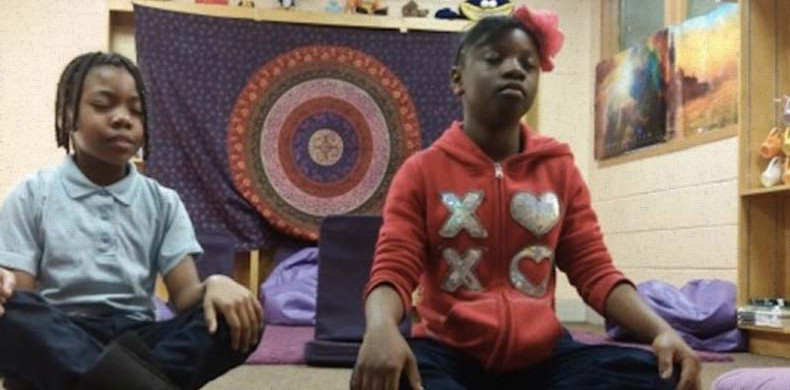Baltimore, MD – It was recently reported that Robert W. Coleman Elementary in West Baltimore will be taking a new and holistic approach to disciplining students. Instead of punishing them or sending them to the principal’s office, administrators will now be sending children to “the mindful moment room” where they will be able to meditate and wind down.
The new policy has been in place for over a year, and in the time that the meditation room has been set up, there has actually been no suspensions throughout the entire year.
The program is an initiative organized by the Holistic Life Foundation, a Baltimore-based nonprofit organization committed to nurturing the wellness of children and adults in underserved communities.
Andres Gonzalez, one of the organizers of the project, says that children are even bringing home what they are learning to their families.
“That’s how you stop the trickle-down effect, when Mom or Pops has a hard day and yells at the kids, and then the kids go to school and yell at their friends,” he says. “We’ve had parents tell us, ‘I came home the other day stressed out, and my daughter said, Hey, Mom, you need to sit down. I need to teach you how to breathe,‘” Gonzalez said.
There are many advantages to meditation, which are now being confirmed by scientific studies. We have learned through scientific research that meditation can relieve pain, enhance creativity, relieve stress and boost immune systems. In 1998, a breakthrough study published in the Journal of the American Medical Association, by a DR. Dean Ornish showed that meditation can actually reverse heart disease. This study lasted for over 5 years and involved various control groups that all had coronary artery disease, and only one of these groups practiced meditation. Amazingly the group that practiced meditation had actually managed to reverse the effects of the illness.
The consistent application of bringing one’s attention to the present moment is key to any form of meditation. This means that nearly any experience can be meditative. A bike ride, a walk under the stars, writing poetry, or any practice that offers individual quiet time within your own heart and mind can be considered a form of meditation.
Over time, various teachers organized their specific meditation practices into cohesive styles and philosophies, each with its own instructions and insights. Around the 5th and 6th centuries BCE, Confucian and Taoist meditations appear in China, and Hindu, Jain, and Buddhist meditations developed in India.
These various schools of meditation taught different methods for remaining in the present moment, some involving the counting of breaths, contemplative thought, or repeating sacred words and sounds known as Mantras.
There are also different types of meditation positions. Some schools practice sitting cross-legged (“lotus” or “half lotus”), walking, or lying down meditation. You also may have noticed that certain traditions will feature symbolic hand gestures and positions during their meditation. These are known as mudras and are found in Hindu and Buddhist practices. People also meditate for different reasons. Most people would say that meditation can be a religious or spiritual experience, while others find it to be a helpful relaxation and anger management tool.
In this one Baltimore school, the powers of living in the present are coming to fruition.
Credits: The Free Thought Project.










Way to go….
Love it! Total transformation.
That’s great